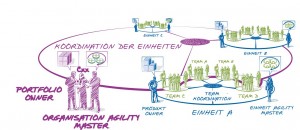Many organizations know the benefits of an agile approach for individual teams. But how are several agile teams coordinated towards one goal? What is the role of leadership? And how do scaled agile approaches help to make the organization faster and more responsive?
"WHEN WE GO INTO THAT NEW PROJECT, WE BELIEVE IN IT ALL THE WAY. WE HAVE CONFIDENCE IN OUR ABILITY TO DO IT RIGHT." Walt Disney
Organizations have to deliver ever more complex products in ever shorter timeframes. Agile scaling accepts the uncertainty associated with increasing complexity and only ever focuses on the most important next step at the time. This allows an organization to react flexibly to changing market conditions. Agile scaling helps to operationalize strategies in self-organized teams.
When implementing Scaled Agile, it has proven to be a good idea to develop your own solution step by step based on an existing framework.
Like Scrum itself, the approaches are referred to as "frameworks" and not as "blueprints". This labeling is intended to make it clear that these are "frameworks" that contain structural specifications similar to the framework of a wooden house, and then still need to be individually designed. The apparent incompleteness of the models is also their great strength.
The frameworks are useful for developing company-specific solutions. The basic rules remain valid for all implementations. At the same time, each organization finds its own way of working together with several agile teams towards a common goal and ensuring a continuous flow from strategic goals to the operational work in the teams. Inspect & Adapt is therefore the central value at the beginning of agile scaling. After all, it is about starting with a first step and continuously developing the solution based on the experience gained.
Our experience from agile scaling projects shows that this learning and improvement focuses on four fields of action.
Agile implementation of strategic goals
The first field is the coordination of the various teams towards a common goal. The models offer ideas for vertical coordination, i.e. the implementation of strategic goals in operational action, and horizontal coordination, i.e. the alignment of teams that deliver components of a common product or service.
The second area is the concrete design of the roles, artefacts and rituals familiar from Scrum for the large organization. Basically, everything applies fractally on a small and large scale: Takt or time slices, PDCA cycle, separation of process and result responsibility.
The third area is the implementation of the separation of powers. Responsibility for WHAT and HOW usually lies withdifferent people. There are the people who formulate and prioritizegoals . They are responsible for an economic service or product. Then there are teams that are responsible for their results. They are self-organized and decide how and how many goals are implemented. And finally, there are people who coach teams and product or service managers. They eliminate disruptions and ensure continuous improvement of work processes.
The fourth area covers the limits of freedom for the individual teams. The self-organization of the teams is certainly one of the success factors of Scrum, as it ensures effectiveness and transparency within the team. However, common architectures, design standards and libraries contain potential for efficiency in the organization. Learning loops help to balance these two forces in line with the corporate culture.
Web tip: There are two well-known frameworks for designing agile organizations:


Write a comment